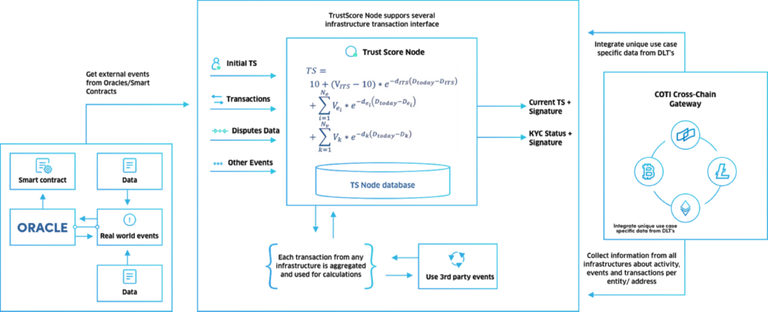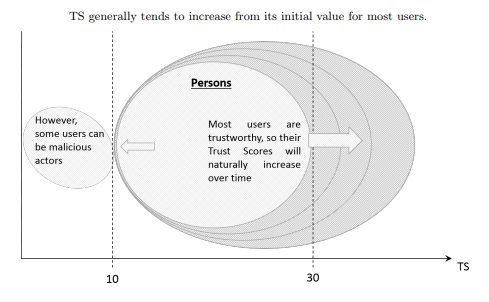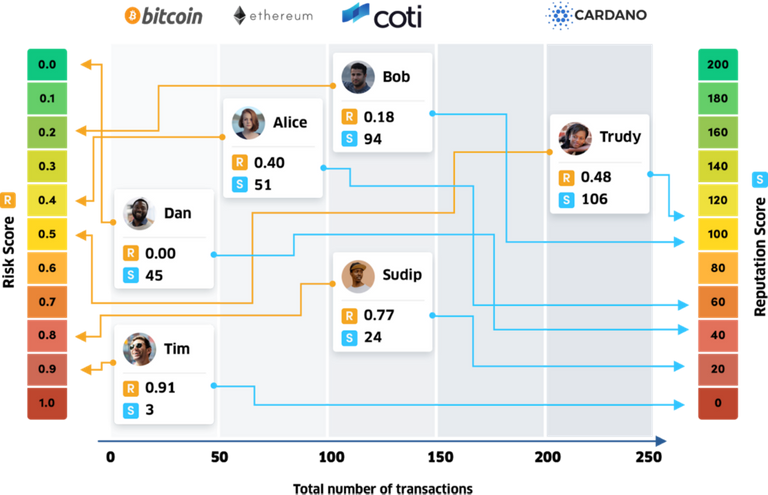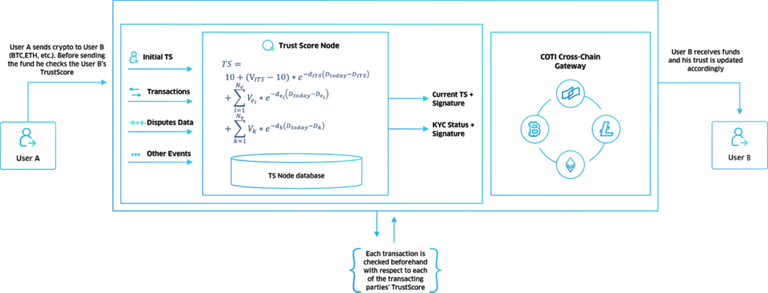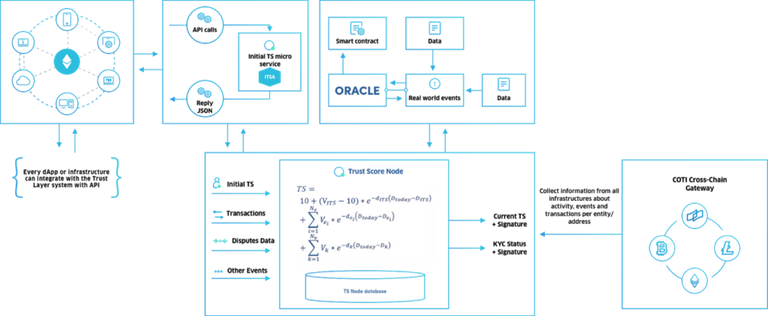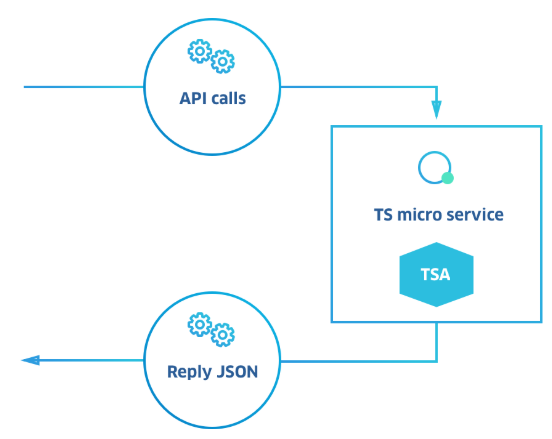Introducing COTI’s Global Trust System (GTS), an advanced layer of trust for any blockchain
By Dr. Nir Haloani, COTI’s CTO

Summary:
- A trustworthy environment is absolutely essential for the widespread adoption of cryptocurrencies.
- COTI has developed a unique Trust Score node in its infrastructure to monitor user behaviour and calculate trust scores as part of its consensus mechanism.
- The Trust Score node is now offered as a service on other chains as part of COTI’s endeavour to introduce more trust and adoption to any blockchain system.
- This Trust Score node is part of COTI’s Global Trust System (GTS), made up of a blacklisting layer to flag fraudulent actors; transaction classification to differentiate high-risk and non-risk activity; and a trust scoring mechanism based on accumulated information and historical performance.
- The COTI GTS connects to all networks and analyzes transaction and behavioral data, updating each entity’s trust score in real time.
- By using the COTI GTS, malicious parties will be actively identified, while reputable behaviour will be tracked and incentivised.
Introduction
Trust is the most important aspect for any effective monetary system. While the distributed architecture of blockchain technology on which cryptocurrencies operate has many advantages, user anonymity on blockchain has provided criminal users with the ability to conceal their identity and illegal activities. In order to distinguish law abiding users from potential threats in the blockchain ecosystem, COTI is presenting an innovative Global Trust System (GTS) that can analyze historical fraud to profile transactions and classify them into risky and non-risky categories using several machine learning techniques and finally calculate a reputation score for every user.
The lack of regulation in borderless technologies presents the challenge of preventing fraud and market manipulation. This is typically handled by central authorities like governments and central banks, as an essential requirement for money to work is trust. Trust has worked as a pillar for monetary exchanges from early civilization, beginning with barter systems and moving on to broader aspects of society-wide monetary systems. Without trust, the honest exchange of goods or services in return for currency payments would be infeasible, and cryptocurrency is no exception in this regard. A trustworthy environment is absolutely essential for the widespread acceptance of cryptocurrency. Transparency is a great generator of trust, and it has a long history as a tool for anti-corruption and anti-money laundering.
A trust mechanism in the form of a reputation score for all users transacting in any blockchain network could alleviate potential illegal activity which negatively impacts good actors. The COTI Global Trust System will enable any infrastructure users to identify and avoid risky parties when sending transactions. In order to mitigate risk, we have built a proprietary scoring mechanism that interprets the trustworthiness of a user in any cryptocurrency network.
Global (Cross-Chain) Trust Scoring System
Transaction Profiling and Scoring Mechanism
Risk is inherent in any transaction, and the potential for fraud exists between any number of transacting parties. While certain measures can be taken to reduce such risks, each party places trust in the other to fulfill its end of the agreement. In order to mitigate this risk, we are introducing the COTI Global Trust System (GTS), which first creates a blacklist of users that are known to be tied to fraudulent activity. Secondly, we are implementing classification techniques to profile all transactions based on their associated risks. Finally, the scoring mechanism, a byproduct of transaction profiling, is a measure of trustworthiness at the user level.
The Blacklist
Blacklisting is one of the primary techniques that organizations use to safeguard the public from financial scams, malicious web pages and many other forms of Internet fraud. In our approach, blacklists identify entities that good actors should avoid transacting with. Our blacklist is continuously updated with all known fraudulent entities, so that users can fully vet them prior to transacting. Once the fraudulent entity is identified, the scoring mechanism generates a warning to inform users of the entity’s blacklisted status, thus providing the benefit of lookup efficiency.
Transaction Profiling and Classification
Every transaction has a specific pattern and this pattern recognition is the key to differentiating high risk and non-risk transactions. We leverage the information gained from past transactions associated with an address and identify similarities between new transactions and an established prototype. Any such similarity would determine a new transaction’s propensity to be risky. We use a variety of machine learning techniques to successfully perform this classification task. Transactions are analyzed based on a set of quantifiable characteristics and are then classified into specific subclasses through a distance function. Successful profiling largely depends on the degree of classification accuracy.
What is the COTI Universal Trust Score?
User trust scores can be viewed as a combination of contributing bonuses and penalties, such as contributions from successful transactions and penalties from irregular behaviour. It seems natural that each of these contributing factors would decay over time, so that more recent events have the most influence over the current user trust score. It would also be logical for different components of the trust score to decay at different rates depending on their severity. For example, if someone has committed serious fraud, then the penalty will decrease slowly with time. This is in contrast to the penalty for a small misdemeanor, which will decay faster and have a smaller long-term impact.
To compute the Trust Score of any entity, two basic components are required: feature variables and labels. The feature variables include every possible attribute that we should measure for a user at a specific point in time (e.g., prior data, actions on the network, etc.), while the labels assign a value to each of these cases. We generally think of the feature variables as determinants of data point positioning in a high dimensional space, and the labels as deciding how to illustrate it.
In the COTI GTS, we define general purpose features that are then used for the ongoing TrustScore (TS) calculation (in the past k transactions / in the past t timespan). Some of the features include:
- Number of successful transactions
- Number of disputed transactions (disputes lost)
- Number of transactions attempted or made that do not adhere to the network’s rules (with no obvious fraudulent intentions)
- Number of possible attempts to double spend/defraud. Actions like this must be critically dealt with to prevent a participant from perpetually building up a high trust score only to attempt defrauding other participants. There should either be a permanent and significant reduction in the participant’s Trust Score, or an extremely slow increase in the Trust Score.
- Frequency of network use. We cannot expect ordinary users to use the network with the same frequency as merchants, so the user type is taken into account.
- User type — the wide range of possible users impacts the trust score awarded to each user type and classification.
- Network centrality
COTI Universal TrustScore Ranking Mechanism
The TrustScore of every entity within the network is appointed in three steps. The first step is the creation of a profile and blacklist analysis based on historical interactions, fraud and blacklisting, as well as analyzing real time behavior of all entity interactions. The blacklist provides good actors with a list of potentially fraudulent entities that they should avoid transacting with. The second step involves a classification module to differentiate good actors from malicious ones. Based on the classification, a metric in the form of a risk score indicates a user’s degree of involvement in malicious transactions. The risk score metric serves as a basis for reputation scoring.
With a successful classification algorithm, a scoring mechanism will designate various user categories. Users with a reputation score below a certain threshold are identified as bad actors. A continuously updated blacklist works as an operating manual for secured transacting across any blockchain network.
The COTI GTS aggregates and connects to all networks to analyze transaction and behavioral data and update each entity’s trust score in real time. By connecting directly with any infrastructure, the COTI reputational management system will be able to collect and analyze all the transactions and specific events related to each platform and ecosystem and adjust the TrustScore feature accordingly.
How it works:
Reputation scoring is widely used in many domains to measure the trustworthiness of a target (e.g., a user or service) based on accumulated information and historical performance. Users observe events that immediately follow a target’s behavior, which determines how they perceive the experience. Events depend on a context and can be, for instance, voiced opinions, transactions, or signed documents. As such, a target’s reputation is a collective measure of trustworthiness accumulated from user experiences. In reputation systems, users can rate the behavior of other users by expressing their direct judgements. The COTI GTS layer aims to calculate the resulting reputation score by collecting, distributing and aggregating the pieces of evidence (events) concerning a target’s behavior in any blockchain network. As a result, before transacting with a target (whether internal or external), the user can consider the target’s reputation and only transact if it is deemed trustworthy.
The COTI GTS framework uses several models to aggregate trust information and compute scores, namely flow-based reputation models and subjective logic. Flow-based reputation models provide an automated way to aggregate all available trust information.
In the first phase, The COTI GTS will be integrated into top infrastructures and aggregate TrustScore information from all of them:
- The COTI Reputation Database and classification will be set per infrastructure.
- Each infrastructure or dApp build atop an infrastructure can connect directly with the COTI GTS through REST API.
- The COTI GTS will also be available publicly on the COTI domain for tracking and searching specific address-related insights and reputational information
- Any transaction on any network can use the API to receive the address TrustScore and base flow, consensus and approval.
- The TrustScore can be easily integrated into any application, smart contract, or oracle use case.
What is next?
In the upcoming weeks we will:
- Announce our first infrastructure partners who will be integrating the COTI Global Trust System
- Release the first version that will support two top infrastructure scoring layers
- Partner with oracle and third party data providers to enhance events and aggregations supported by the platform framework.
Summary
By fully migrating our TrustScore and Ranking mechanism and applying it to any infrastructure, we will empower any network to address the issue of trust between unknown parties. COTI has developed a ranking mechanism to track the behavioral data of network entities, which is crucial for any service running on any platform, infrastructure or chain. In the framework of COTI’s reputational scoring system, malicious parties are actively identified and addressed, while reputable behaviour is tracked and incentivised. Moreover, the engine is customized per each use case, as each industry faces varying levels of risk. By using the reputational scoring system, any infrastructure and chain will be able to leverage efficient behavioural tracking, a data layer that is chiefly missing in the crypto world, in order to maintain trust scores and risk indicators for all consumers and merchants.
For other COTI news, you can stay up to date on our Telegram channel.
COTI Resources
Website: https://coti.io
Telegram group: https://t.me/COTInetwork
Github: https://github.com/coti-io
Technical whitepaper: https://coti.io/files/COTI-technical-whitepaper.pdf
